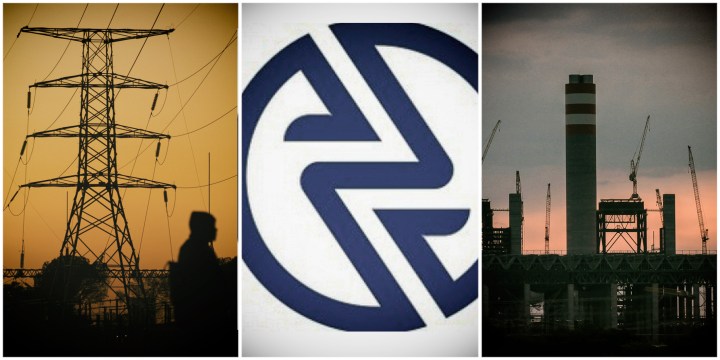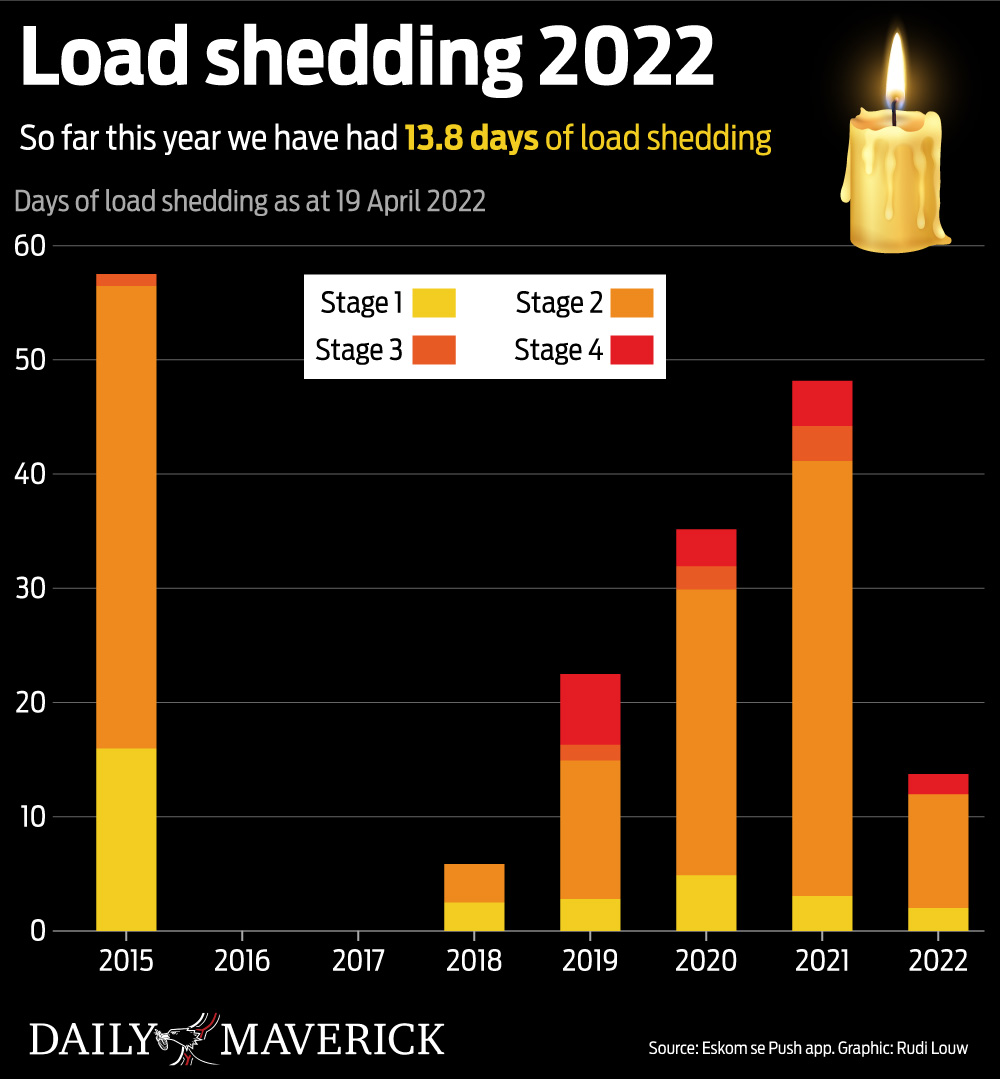ESKOM ALERT
Stage 4 power cuts hit South Africa as nearly half the grid fails over Easter

Eskom executives hope Stage 6 power cuts will not be necessary as cold weather and rain increase demand.
With less than a minute’s notice, Eskom plunged South Africa into Stage 4 power cuts on Tuesday, 19 April, as it lost multiple units at multiple power stations.
The utility expects to be able to end load shedding on Friday, 22 April, but it can’t say this with certainty.

At the weekend, Eskom gave South Africans seven minutes’ notice before implementing Stage 2 power cuts as cold weather increased demand, and it lost units at both old and new power stations. The utility lost just more than 17,000MW of power (it has an installed capacity of about 44,000MW) and had 5,700MW out on planned maintenance. This means about half the country’s grid was out. South Africa relies on open-cycle gas turbines that run on diesel, and capacity is running low because of global supply shortages caused by the war in Ukraine.
It was costly, too. Senior researcher at the Council for Scientific and Industrial Research, Dr Ridhwaan Suliman, tweeted that these turbines cost R700,000 per unit per hour to operate. They are running almost all the time to keep electricity supply going even at limited provision. In six years South Africa has not built a new generation capacity, said Eskom CEO Andre de Ruyter at a briefing to the country.
He said it takes longer to bring own-generation plants onto the grid because of bureaucratic red tape and a long regulation process. Nersa, which regulates electricity “is reconsidering (regulatory processes) to allow the quickest generation of capacity to the grid”.
How eThekwini staffers tried to hijack food meant for rescuers of the dead and displaced
In June 2021, President Cyril Ramaphosa announced that private power generators would be able to produce up to 100MW, and many have started plants for their own generation, but this has not taken the pressure off the national grid.
De Ruyter said Eskom had offered three-year contracts to small generators in August 2021 but was waiting for approval from Nersa and the Department of Mineral Resources and Energy. There is pent-up demand to produce, he said, because there had been a positive response to Eskom’s planned land release in Mpumalanga, with 64 parties attending a call. “Stage 4 is a call to arms to bring a system to a much greater level of stability,” he said.
South Africa is in its 14th year of planned blackouts, while Ramaphosa promised that these would end in 2019.
Eskom’s head of generation, Philip Dukashe, said demand on the cold Easter weekend was between 700MW and 1,200MW higher than forecast.
The utility was unable to take some planned units off-grid for maintenance. “[We] Still have units at risk – 11,000MW can fail at any stage,” said Dukashe, illustrating the frailty of the system.
The record outage for Eskom was when 18,000MW was lost to power cuts and the Easter weekend came quite close to this high.
Dukashe said Eskom did not expect to go to Stage 6 this week because it had made contingency plans. Stage 6 is the highest level of planned cuts. Eskom said it forecast 37 days of total outages for the year, with an extreme forecast of 101 days, adding that this was “very, very far” away. The grid will be returned to a firmer footing by Thursday evening, with this round of power cuts expected to end on Friday morning.
Johannesburg had an additional 2,000 power cuts last week, according to authorities. The city grid is at its life-end, and Eskom’s power cuts hasten its demise because the system overloads when it is constantly switched on and off.
Cape Town is one load-shedding level below the rest of the country because the city buys power from independent power producers to lessen the burden on its residents.
Daily Maverick readers told us how load shedding affects their businesses here. Ray Mahlaka reported on the 14th birthday of load shedding in 2021, saying it whacks growth and employment by multiple percentage points. DM
[hearken id=”daily-maverick/9366″]

















 Become an Insider
Become an Insider
What Eskom needs to do is bring back some people with experience that were so easily disposed of. clearly such experience is required with urgency. This country cannot carry on like this with the onus being put on consumers to save electricity only to discover that such savings end in harsh results like load shedding or power cuts or whatever name one gives. Eskom get your act together and buy back lost experience.
Thank goodness that the DA governs Cape Town.
The ANC should consider load shedding in this way. Each stage 2 load shedding period represents a 0.25 per cent loss in the 2024 national elections. Each stage 4 load shedding period represents a 0.5 per cent loss in the 2024 national elections etc. The ANC can inform us what each 1 per cent loss means in lost revenue, both from legitimate party funding and what I would imagine is a much higher figure, corruption opportunities.
“Cape Town is one load-shedding level below the rest of the country because the city buys power from independent power producers to lessen the burden on its residents.” So Cape Town is way ahead of the game, stretching its lead and lessening the residents come first. So why isn’t everywhere else doing it?
It’s not half the grid that has failed, but half the generation plant fleet. Also it’s not true that no new generation capacity has been added in 6 years. Last year, about 1000 MW of renewables were added by IPPs. But we need to add 5000 MW of RE capacity per year to replace the old coal-fired plants that must all be retired this decade.
So while the kleptos were devising ways to steal from Eksdom and employing too many people at excessive salaries, no forward planning was done at all. This can only be as a result of the incompetence and dishonesty of the deployed cadres who populate the company.
This may be a naive comment but what if Eskom spent a few Bob on a plea to the public to institute voluntary cuts PRIOR to load shedding as a life style until the supply situation improves. I am sure all of us, including much of Industry and commerce could reduce consumption by 10% without feeling much pain?
Absolutely. If we all turned off our pool pumps and geysers just prior to load shedding, it wouldn’t need to happen.
Once you go solar you learn to do this automatically; if the weather is inclement, you wash the dishes by hand. That’s a lot easier than Eskom making you wash the dishes by hand, and everything else that goes with it.
The upside of this is that Eskom is forcing SAs to make a plan; and that’s good for global warming.
Without a doubt one of the most important decisions we ever made was to build a solar power unit on our roof. The first phase I built myself; it’s not rocket science but I am a physics major. Old and grey the second phase was built by a commercial operation; they did a good job. Yes, the lithium batteries were costly, but simply by preserving our sanity it has paid off many times over. There’s worse to come.